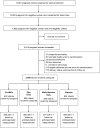Effect of zinc and multivitamin supplementation on the growth of Tanzanian children aged 6-84 wk: a randomized, placebo-controlled, double-blind trial
- PMID: 26817503
- PMCID: PMC4763494
- DOI: 10.3945/ajcn.115.120055
Effect of zinc and multivitamin supplementation on the growth of Tanzanian children aged 6-84 wk: a randomized, placebo-controlled, double-blind trial
Abstract
Background: Poor child growth increases risks of mortality and morbidity. Micronutrient supplements have the potential to improve child growth.
Objective: We assessed the effect of daily zinc, multivitamin (vitamins C, E, and B-complex), and zinc and multivitamin (Zn+MV) supplementation on growth in infants in Tanzania.
Design: In this randomized, 2 × 2 factorial, double-blind trial, 2400 infants were randomly assigned to receive zinc, multivitamins, Zn+MVs, or a placebo at 6 wk of age and were followed up for 18 mo with monthly growth measurements. Mixed-effects models with restricted cubic splines for the mean change in anthropometric z scores were fit for each group. Likelihood ratio tests were used to compare the effect of supplements on growth trajectories. Cox proportional hazards models were used to compare incidences of stunting, wasting, and underweight.
Results: Children in all groups experienced growth faltering. At 19 mo of age, prevalences of stunting, wasting, and underweight were 19.8%, 6.0%, and 10.8%, respectively. Changes in weight-for-age z scores (WAZs) and weight-for-height z scores (WHZs) were significantly different across the 4 groups (P < 0.001 for both). The mean ± SE decline in the WAZ from baseline to the end of follow-up in the Zn+MV group was significantly less than in the placebo group (-0.36 ± 0.04 compared with -0.50 ± 0.04; P = 0.020), whereas the decline in the WHZ was significantly greater in the zinc-only group than in the placebo group (-0.57 ± 0.07 compared with -0.35 ± 0.07; P = 0.021). Supplements did not have a significant effect on mean change in the height-for-age z score or on rates of stunting, wasting, or underweight.
Conclusions: Although there were small but significant improvements in the WAZ in the Zn+MV group, daily zinc supplementation alone, multivitamin supplementation alone, and the combined Zn+MV did not reduce the incidences of underweight, stunting, or wasting in Tanzanian infants. Alternative approaches to prevent growth faltering should be pursued. This trial was registered at clinicaltrials.gov as NCT00421668.
Keywords: growth; infancy; multiple micronutrients; supplementation; zinc.
© 2016 American Society for Nutrition.
Figures


Similar articles
-
Daily Zinc but Not Multivitamin Supplementation Reduces Diarrhea and Upper Respiratory Infections in Tanzanian Infants: A Randomized, Double-Blind, Placebo-Controlled Clinical Trial.J Nutr. 2015 Sep;145(9):2153-60. doi: 10.3945/jn.115.212308. Epub 2015 Jul 22. J Nutr. 2015. PMID: 26203094 Free PMC article. Clinical Trial.
-
Multivitamin supplements have no effect on growth of Tanzanian children born to HIV-infected mothers.J Nutr. 2013 May;143(5):722-7. doi: 10.3945/jn.112.170498. Epub 2013 Mar 20. J Nutr. 2013. PMID: 23514773 Free PMC article. Clinical Trial.
-
No effect of maternal micronutrient supplementation on early childhood growth in rural western China: 30 month follow-up evaluation of a double blind, cluster randomized controlled trial.Eur J Clin Nutr. 2012 Feb;66(2):261-8. doi: 10.1038/ejcn.2011.190. Epub 2011 Nov 16. Eur J Clin Nutr. 2012. PMID: 22085869 Clinical Trial.
-
Zinc Supplementation for Promoting Growth in Children Under 5 years of age in Low- and Middle-income Countries: A Systematic Review.Indian Pediatr. 2019 May 15;56(5):391-406. Epub 2019 Mar 17. Indian Pediatr. 2019. PMID: 30898990
-
Nutritional interventions for preventing stunting in children (birth to 59 months) living in urban slums in low- and middle-income countries (LMIC).Cochrane Database Syst Rev. 2019 Jun 17;6(6):CD011695. doi: 10.1002/14651858.CD011695.pub2. Cochrane Database Syst Rev. 2019. PMID: 31204795 Free PMC article.
Cited by
-
Effects of prenatal and postnatal maternal multiple micronutrient supplementation on child growth and morbidity in Tanzania: a double-blind, randomized-controlled trial.Int J Epidemiol. 2022 Dec 13;51(6):1761-1774. doi: 10.1093/ije/dyab117. Int J Epidemiol. 2022. PMID: 34151973 Free PMC article. Clinical Trial.
-
Effects of Zinc Supplementation on Metabolomic Profiles in Tanzanian Infants: A Randomized Trial.J Nutr. 2024 Feb;154(2):403-411. doi: 10.1016/j.tjnut.2023.12.011. Epub 2023 Dec 11. J Nutr. 2024. PMID: 38092153 Free PMC article. Clinical Trial.
-
Zinc supplementation for the promotion of growth and prevention of infections in infants less than six months of age.Cochrane Database Syst Rev. 2020 Apr 8;4(4):CD010205. doi: 10.1002/14651858.CD010205.pub2. Cochrane Database Syst Rev. 2020. PMID: 32266964 Free PMC article.
-
Biomarkers of Systemic Inflammation and Growth in Early Infancy are Associated with Stunting in Young Tanzanian Children.Nutrients. 2018 Aug 24;10(9):1158. doi: 10.3390/nu10091158. Nutrients. 2018. PMID: 30149537 Free PMC article.
-
The effect of zinc supplementation on anthropometric measurements in healthy children over two years: a systematic review and meta-analysis.BMC Pediatr. 2023 Aug 23;23(1):414. doi: 10.1186/s12887-023-04249-x. BMC Pediatr. 2023. PMID: 37612628 Free PMC article.
References
-
- Black RE, Victora CG, Walker SP, Bhutta ZA, Christian P, de Onis M, Ezzati M, Grantham-McGregor S, Katz J, Martorell R. Maternal and child undernutrition and overweight in low-income and middle-income countries. Lancet 2013;382:427–51. - PubMed
-
- Christian P, Tielsch JM. Evidence for multiple micronutrient effects based on randomized controlled trials and meta-analyses in developing countries. J Nutr 2012;142:173S–7S. - PubMed
-
- Gibson RS. Zinc: the missing link in combating micronutrient malnutrition in developing countries. Proc Nutr Soc 2006;65:51–60. - PubMed
Publication types
MeSH terms
Substances
Associated data
Grants and funding
LinkOut - more resources
Full Text Sources
Other Literature Sources
Medical

